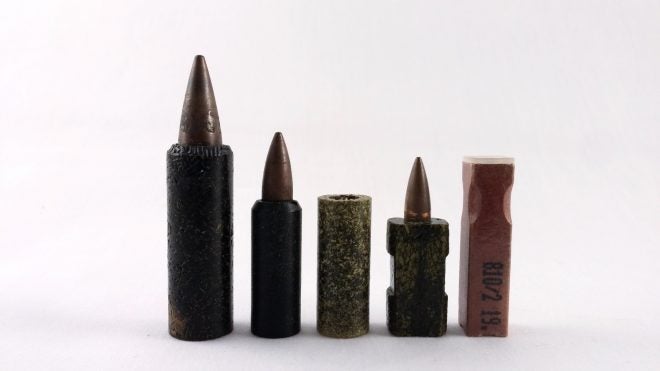Caseless: The ammunition designer’s holy grail, and the engineer’s worst nightmare. It would obsolete the cartridge case overnight, resulting in cheaper, lighter, and more compact ammunition. Weapons would be able to carry 50, 60, or more rounds in slim, inexpensive magazines, and expel them at a rate of fire much higher than current weapons are capable of – not only because the ammunition is lighter and therefore more could be carried to feed such thirsty guns, but because the extraction and ejection cycles of the weapons themselves could be eliminated.
The G11K2 is the posterchild of what might have been.
The result is, potentially, the greatest advancement in small arms since the invention of the very self-contained cartridge it would replace. That is, if the kinks can be worked out – and what kinks there are! The problems facing caseless are so great that many consider the idea to be a dead-end, with no possible practical application for small arms. “It’ll never happen” is the mantra of many when it comes to caseless ammunition.
This post is not about caseless. Well, not directly. Instead it’s a bit of a perspective check when talking about speculative technological developments, especially those in small arms. Caseless ammunition is perhaps the poster child of these, but many other technologies receive the same chilly welcome from critics. Polymer cased composite and telescoped ammunition, flechette rounds, electrical firing, and other future firearms technologies all get dismissed as impractical wastes of time on the grounds that “if they were going to work, they would already”.
I don’t think that’s true, though, and I’ll explain why. When we think about technological development, we tend to gravitate towards the biggest discoveries and the biggest inventions. A leads to B, Einstein’s breakthoughs in physics led to the atomic bomb, a sort of linear technology tree where one advancement leads to the next and the next. In this context, caseless and other slow-brewing technologies do seem like dead ends. The big breakthroughs that begat them have come and gone, and still we’re not seeing their fruits. Stop wasting money on them, move on, accept that the dream is dead.
Or is it? See, the reality is that many – probably most, in fact – technological advancements do not occur this way. One big breakthrough does not beget a product directly. Rather, a slowly advancing undercurrent of manufacturing finesse gradually opens the doors to the exploitation of more technologies as their implementation becomes more and more practical with time. Allow me to clarify with an example: Think back to your high school chemistry course, with its Erlenmeyer flasks, vials, graduated cylinders, beakers, and other glassware. Each of these items is essential to demonstrating many physical properties. The principle of conservation of mass, for example, could not be demonstrated (and therefore discovered) without sufficiently regulated and sealed glassware, and such glassware could not exist without technically proficient and well-equipped glassblowers. Before each object used in the advancement of science goes a parade of incremental refinement of one or more arts. To create a precise instrument, one must have other precise instruments with which to make it, and those need instruments to make them, and so on.
Today, we are seeing the beginnings of a movement towards fielding low-weight, crisp combat triggers on every standard issue rifle fielded by military forces. These triggers are technically amazing devices, held to a degree of precision beyond a level that was only attainable from the hands of experienced artisans a few decades ago. Now, they can be mass-produced and every infantryman thereby reap the benefits of a short pull and a crisp break. It is small improvement, but a technically significant one, and it would have been unthinkable 50 years ago. Yet, no major breakthrough begat this; things just got… Better.
When I see naysaying about future technologies, I ground myself with a single, powerful counter-example. Breechloading firearms were, for literally hundreds of years, the caseless weapons of their era. In Henry VIII’s day, they were curiosities too expensive and too delicate to be practical for anything but the amusement of the ultra-rich. At the time, metallurgy and metalworking were not refined enough to create strong locking surfaces, propellants were too dirty and their burn rate too uneven for rubber seals to last long, and if you had suggested to an ingenieur of the day that they somehow produce millions of brass shells with walls no thicker than a fingernail, they would have laughed at the joke. Yet, eventually, each of these arts moved forward on the steady undercurrent of refinement, and today breechloaders are not only practical, but have been taken for granted for over 150 years. How things change!
Is cased telescoped ammunition the next big thing, or the latest dead end?
Will caseless, or power armor, or any of the other ambitious infantry technologies ever break through the boundaries of experiment and into the practical realm? I have no idea, and I maintain a healthy reserve of doubt in each case. But, before we say “never”, we should remember that never is an awfully long time.
 Your Privacy Choices
Your Privacy Choices


